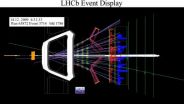(Press-News.org) Chicago, IL (May 2, 2014) — International leaders in the fields of gastroenterology and hepatology will gather together for Digestive Disease Week® (DDW) 2014, the largest and most prestigious gastroenterology meeting, from May 3 to 6, 2014, at McCormick Place in Chicago, IL. DDW is jointly sponsored by the American Gastroenterological Association (AGA) Institute, the American Association for the Study of Liver Diseases (AASLD), the American Society for Gastrointestinal Endoscopy (ASGE) and the Society for Surgery of the Alimentary Tract (SSAT).
AGA researchers will present exciting, cutting-edge data during the meeting that will help change the way physicians diagnose and treat gastrointestinal (GI) disorders. All data presented during DDW is embargoed until the beginning of the presentation or an official DDW press conference, whichever occurs first. A list of press activities is available at http://www.ddw.org/press. Newsroom staff can facilitate interviews with researchers presenting at the sessions highlighted below.
All sessions will be held in McCormick Place (Central Time). For more information on presentations and data being presented, visit http://www.myddw.org.
Plenary Sessions
The 2014 joint ASGE-AGA Presidential Plenary Session will take place on May 4 from 1:30 to 5 p.m. in the Arie Crown Theater.
AGA Institute President, Anil K. Rustgi, MD, AGAF, and his ASGE counterpart have invited noted experts to present on hot topics in gastroenterology and GI endoscopy. Presentations include:
"Have We Reached the Top for IBD Therapy?" Gary R. Lichtenstein, MD, Hospital of the University of Pennsylvania, Philadelphia
"Pancreatic Cancer: Have We Made Progress?" Andrew D. Rhim, MD, University of Michigan Health System, Ann Arbor
"Colorectal Polyps: Is the Resect and Discard Strategy Ready for Primetime?" Pro: Douglas K. Rex, MD, AGAF, Indiana University, Indianapolis; Con: Robert H. Riddell, MD, Mount Sinai Hospital, Toronto, Ontario, Canada
"IBS and FODMAP," Lin Chang, MD, AGAF, David Geffen School of Medicine at University of California, Los Angeles
"Dietary Effects of the Gut Microbiome," Gary D. Wu, MD, Perelman School of Medicine at the University of Pennsylvania, Philadelphia
"C. Difficile Infection and Fecal Microbiota Transplantation," Colleen R. Kelly, MD, Warren Alpert Medical School of Brown University, Providence, RI
"HCV Therapy in 2014," David Thomas, MD, MPH, John Hopkins Center for Global Health, Baltimore, MD
AGA will also host a Basic Science Plenary Session on May 4 from 10 to 11:30 a.m. in Room S102ABC.
Late-Breaking Abstract Sessions
Two late breaking abstract sessions will highlight new data accepted for presentation at DDW:
Basic science late-breaking abstracts: May 6, 8 to 9:30 a.m., in Room S105A
Clinical science late-breaking abstracts: May 6, 10 to 11:30 a.m., Room S102ABC
Scientists present late-breaking abstracts during posters sessions on May 6, 8 a.m. to 5 p.m. ET, South Hall. Researchers will be present at their posters from noon to 2 p.m.
Other exciting data will be presented during DDW, including 61 clinical symposia, 16 research symposia, 10 translational symposia, 10 state-of-the-art lectures, six distinguished abstract plenary sessions, and other committee-sponsored and special sessions on a range of GI topics. Additionally, the AGA Institute will sponsor four curbside consultant sessions. A total of 10 focused research roundtables and focused clinical updates — breakfast sessions designed to help participants choose the must-see basic science and clinical research abstracts presented during DDW — will occur throughout the meeting.
AGA has also developed special tracks for minority physician-scientists and trainees and young GIs.
INFORMATION:
About the American Gastroenterological Association
The American Gastroenterological (AGA) Association is the trusted voice of the GI community. Founded in 1897, the American Gastroenterological Association has grown to include close to 17,000 members from around the globe who are involved in all aspects of the science, practice and advancement of gastroenterology. The AGA Institute administers the practice, research and educational programs of the organization. Learn more at http://www.gastro.org.
Follow us on Twitter @AmerGastroAssn. Become an AGA fan on Facebook.
About DDW
DDW is the largest international gathering of physicians, researchers and academics in the fields of gastroenterology, hepatology, endoscopy and gastrointestinal surgery. Jointly sponsored by the American Association for the Study of Liver Diseases (AASLD), the American Gastroenterological Association (AGA) Institute, the American Society for Gastrointestinal Endoscopy (ASGE) and the Society for Surgery of the Alimentary Tract (SSAT), DDW takes place May 3-6, 2014, at McCormick Place, Chicago, IL. The meeting showcases more than 5,000 abstracts and hundreds of lectures on the latest advances in GI research, medicine and technology. For more information, visit http://www.ddw.org.
Follow us on Twitter @DDWMeeting; hashtag #DDW14. Become a DDW fan on Facebook.
AGA unveils latest advances in GI research at DDW 2014
2014-05-02
ELSE PRESS RELEASES FROM THIS DATE:
Nature's chemical diversity reflected in Swedish lakes
2014-05-02
It's not only the biology of lakes that varies with the climate and other environmental factors, it's also their chemistry. More knowledge about this is needed to understand the ecology of lakes and their role in the carbon cycle and the climate. Today an international research group led by Uppsala University is publishing a comprehensive study of the composition of organic compounds in the prestigious journal Nature Communications.
- Lake water is like a very thin broth with several thousand ingredients in the recipe, all with different properties. At the same time ...
Stimulated mutual annihilation
2014-05-01
Twenty years ago, Philip Platzman and Allen Mills, Jr. at Bell Laboratories proposed that a gamma-ray laser could be made from a Bose-Einstein condensate (BEC) of positronium, the simplest atom made of both matter and antimatter (1). That was a year before a BEC of any kind of atom was available in any laboratory. Today, BECs have been made of 13 different elements, four of which are available in laboratories of the Joint Quantum Institute (JQI) (2), and JQI theorists have turned their attention to prospects for a positronium gamma-ray laser.
In a study published ...
Syracuse University physicists confirm existence of new type of meson
2014-05-01
Physicists in the College of Arts and Sciences at Syracuse University have made several important discoveries regarding the basic structure of mesons—subatomic particles long thought to be composed of one quark and one antiquark and bound together by a strong interaction.
Recently, Professor Tomasz Skwarnicki and a team of researchers proved the existence of a meson named Z(4430), with two quarks and two antiquarks, using data from the Large Hadron Collidor beauty (LHCb) Collaboration at CERN in Geneva, Switzerland. This tetraquark state was first discovered in Japan ...
Investigators find something fishy with classical evidence for dietary fish recommendation
2014-05-01
Philadelphia, PA, May 1, 2014 – Oily fish are currently recommended as part of a heart healthy diet. This guideline is partially based on the landmark 1970s study from Bang and Dyerberg that connected the low incidence of coronary artery disease (CAD) among the Eskimos of Greenland to their diet, rich in whale and seal blubber. Now, researchers have found that Eskimos actually suffered from CAD at the same rate as their Caucasian counterparts, meaning there is insufficient evidence to back Bang and Dyerberg's claims. Their findings are published in the Canadian Journal ...
Atypical form of Alzheimer's disease may be present in a more widespread number of patients
2014-05-01
JACKSONVILLE, Fla. — Neuroscientists at Mayo Clinic in Florida have defined a subtype of Alzheimer's disease (AD) that they say is neither well recognized nor treated appropriately.
The variant, called hippocampal sparing AD, made up 11 percent of the 1,821 AD-confirmed brains examined by Mayo Clinic researchers — suggesting this subtype is relatively widespread in the general population. The Alzheimer's Association estimates that 5.2 million Americans are living with AD. And with nearly half of hippocampal sparing AD patients being misdiagnosed, this could mean that ...
JCI online ahead of print table of contents for May 1, 2014
2014-05-01
Balancing protein turnover in the heart
Alterations in the ubiquitin proteasome system (UPS), which tags proteins for degradation, underlies some cardiomyopathies and age-related cardiac dysfunction. In the heart, the UPS is essential for the precise balance between cardiomyocyte atrophy and hypertrophy. In skeletal muscle, the E3 ubiquitin ligase atrogin-1 promotes atrophy by targeting hypertrophy-associated proteins for degradation; however, a role for atrogin-1 in cardiac proteostasis is not clear. In this issue of the Journal of Clinical Investigation, Marco Sandri, ...
Undersea warfare: Viruses hijack deep-sea bacteria at hydrothermal vents
2014-05-01
More than a mile beneath the ocean's surface, as dark clouds of mineral-rich water billow from seafloor hot springs called hydrothermal vents, unseen armies of viruses and bacteria wage war.
Like pirates boarding a treasure-laden ship, the viruses infect bacterial cells to get the loot: tiny globules of elemental sulfur stored inside the bacterial cells.
Instead of absconding with their prize, the viruses force the bacteria to burn their valuable sulfur reserves, then use the unleashed energy to replicate.
"Our findings suggest that viruses in the dark oceans indirectly ...
Excessive regulations turning scientists into bureaucrats
2014-05-01
Excessive regulations are consuming scientists' time and wasting taxpayer dollars, says a report released today by the National Science Board (NSB), the policymaking body of the National Science Foundation and advisor to Congress and the President.
"Regulation and oversight of research are needed to ensure accountability, transparency and safety," said Arthur Bienenstock, chair of the NSB task force that examined the issue. "But excessive and ineffective requirements take scientists away from the bench unnecessarily and divert taxpayer dollars from research to superfluous ...
Electronic nose sniffs out prostate cancer using urine samples
2014-05-01
New York, NY, May 1, 2014 – We may soon be able to make easy and early diagnoses of prostate cancer by smell. Investigators in Finland have established that a novel noninvasive technique can detect prostate cancer using an electronic nose. In a proof of principle study, the eNose successfully discriminated between prostate cancer and benign prostatic hyperplasia (BPH) by "sniffing" urine headspace (the space directly above the urine sample). Results using the eNose are comparable to testing prostate specific antigen (PSA), reports the Journal of Urology®.
Prostate cancer ...
Oral Cancer linked to human papillomavirus: No increased HPV risk for long-term partners
2014-05-01
Partners of patients diagnosed with human papilloma virus (HPV)-positive oropharyngeal cancer (OPC) were no more likely to test positive for oral HPV infection than people in the general population, according to a study published in the April 28 online edition of the Journal of Clinical Oncology. The findings should lessen anxiety that OPC cancer is contagious, at least among long-term partners, and confirms that couples who have been together for several years do not need to change their intimacy or sexual behavior because of the cancer diagnosis.
HPV infection is common ...



